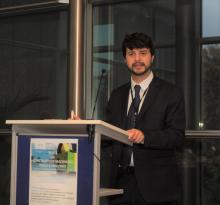
Every company needs to stay ahead of the digital curve, but few go so far as inviting hackers to take over their systems. Construction equipment company
Volvo Construction Equipment (CE) has staged its first hackathon with the aim of providing a clever answer to a common problem: how to increase a company’s digital diversity.
The ‘Hack Sprint’ event, a collaboration with Volvo Group Connected Solutions, was designed to engage a completely new demographic in order to increase the company’s technology skills. A number of digital specialists – or ‘hackers’ – were invited into the Swedish company’s headquarters at the end of last year and were tasked with solving a key problem for Volvo CE: how to simplify the time-consuming manual process of undercarriage wear inspections. And if successful, potentially partner with Volvo CE on future technology solutions.
“A lot of us have been in the industry for 10, 20, even 30, years and we are all looking at this problem in a specific paradigm,” says Mya Istanbouly, global manager of business intelligence & analytics at Volvo CE. “We thought, what if we have other people look at this problem for us. A completely new generation of thinkers and developers. People who might have completely different ideas of how we could do these wear inspections.”
Contestants were shown the excavator and the undercarriage components and taken through what the current inspection process is, then asked to come up with mobile-based image processing solutions that would improve the process.
There were, however, skeptics within the company. “One Volvo CE employee, who has been with the company for 30 years, really thought that the task would be impossible for the hackers,” says Istanbouly. “He was so adamant that it wasn’t going to work that he insisted on being at the event. He wanted to make sure that the candidates really understood the complexity of the problem. But after 72 hours, he was just as stunned as the rest of us.”
Over a three-day period, the hackers – mostly aged in their early 20s – had created mobile apps that used a mobile phone camera to take measurements – far more accurate than a human eye. And in doing so, they had taken inspection times down from one hour to a few minutes.
Out of 200 applications, 80 were chosen to take part based on diversity of age, gender, nationality and skillsets. The result was a group of young people who came from all over the world – Singapore, France, Belgium, Ukraine, Germany, Sweden.
Istanjbouly believes this is a key element of the success behind the scheme. “Instead of having one particular ethnic background in the room who are all thinking about a problem in a certain way, you have a multicultural group who are all thinking about the same problem in a different way,” she says. “And you could actually see it happening in the room. You saw new groups forming, mixing their ideas and perspectives. And this is how innovation happened.”
The winners of the Best Hack Award from the event, Sigma Software Group, impressed judges because they had the courage to demonstrate an actual app in real-time to show the accurate measurements of their image processing software.
Other winners included a group of students from Halmstad University who won the Best Technical Solution Award because of the specific algorithms they implemented.
The concept was exhibited as a prototype at
Despite this success, Istanbouly admits that she did not actually think that the Hackathon would produce actual solutions. “Our initial aim was just to drum up interest in a new demographic,” she says. “The construction industry needs to diversify its skillsets as we move into the technical revolution and we saw this event as a way of framing the company as a cool place to work, a place where you can use what you’ve studied and what you love and solve real-world problems.”
Technology is drastically reshaping the industry and beyond, so why does construction endure an outdated perception when it comes to its digital offering?
“We’ve limited ourselves in terms of the applications of image processing” Istanbouly responds. “Historically, we’ve focused on what’s going on around the machine, but we need to focus on what is happening to the machine as well. Image processing is one way of knowing how much a machine is wearing down. No electronics are going to pick up on that, we need eyes on it, even if those eyes aren’t human.”
She adds that the construction equipment industry has the potential to follow the example of Google and Apple, companies that are creating augmented reality (AR) to look at all sorts of data in real-time, and measure it without a point of reference.
Volvo CE says its hackathon has shown just how much is possible, and that it’s “an exciting thought” that technologies like this could be the answer to improving machine maintenance, machine health, emission standards or safety.










